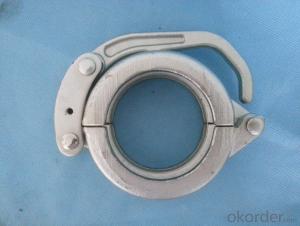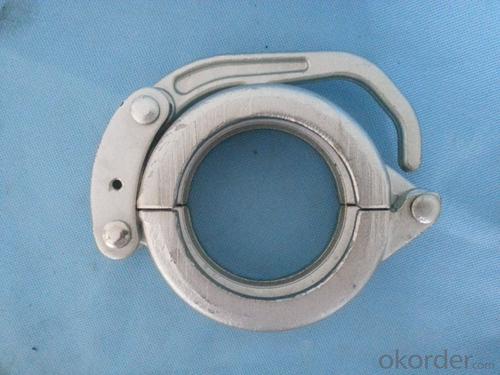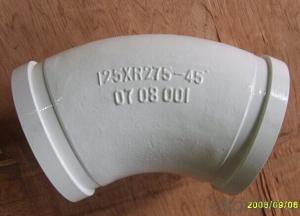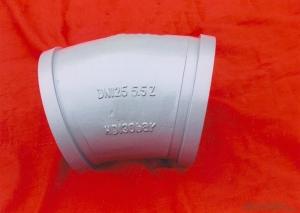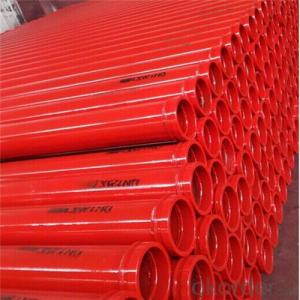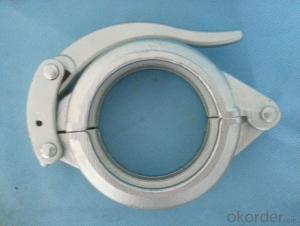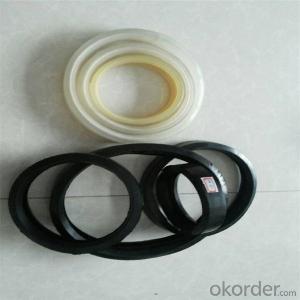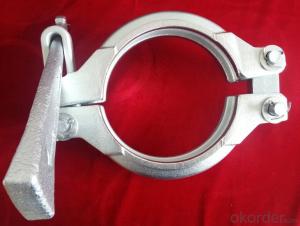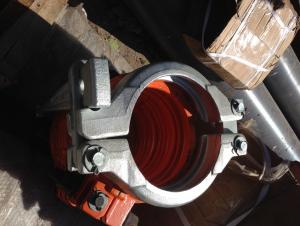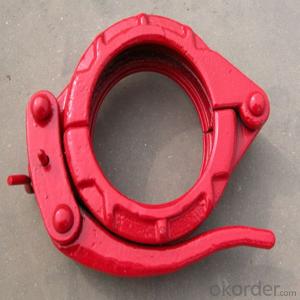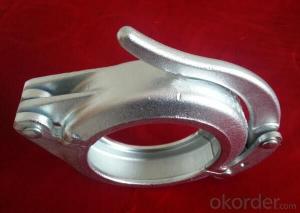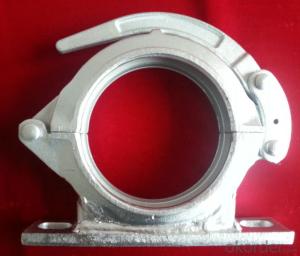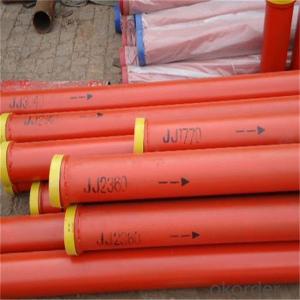Concrete Pump Clamp DN80 3-1/4
- Loading Port:
- China main port
- Payment Terms:
- TT OR LC
- Min Order Qty:
- 20 PCS
- Supply Capability:
- 1000 PCS/month
OKorder Service Pledge
OKorder Financial Service
You Might Also Like
Product Description:
A coupling is a device used to connect two delivery pieps together at their ends for the purpose of transmitting, and prevent the concrete from leaking. Couplings do not normally allow disconnection of shafts during operation.
Main Product Features:
1. use high quality steel. After high-temperature 1200 forging,it’s shaped.
2.High temperature forging.
3.convenient to use, easy operation,and high safety.
4.good sealing,wear-resising,longer service life.
5.do not restrict the steering tubes, pipes during the working process can be 360 degrees rotation.
6.used in concrete pump truck,concrete pump and pipeline connection seal in construction
work equipment.
Product Specifications:
1.Forged
2.2--8 inch
3.Galvanizing/Baking varnish
4.More durable,light,beautiful
Production steps:
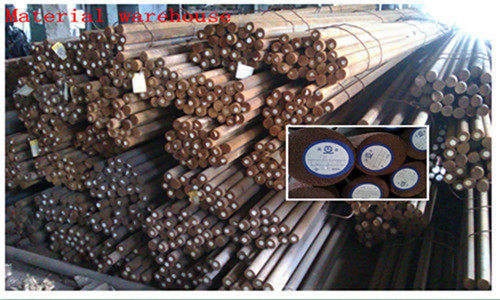
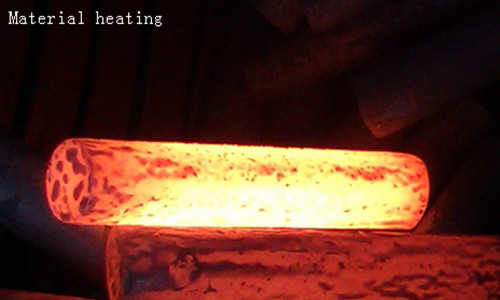
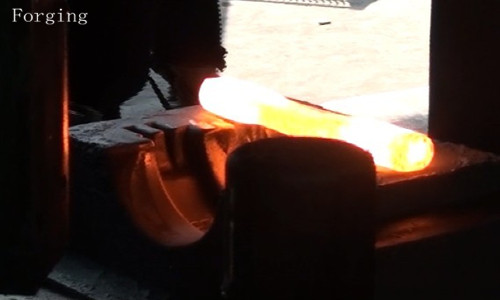
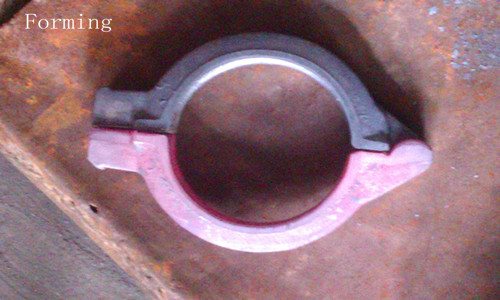
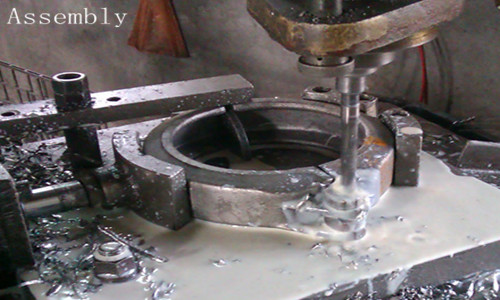
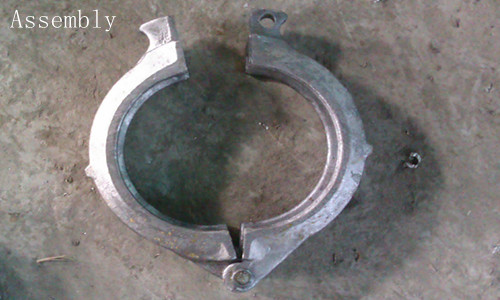
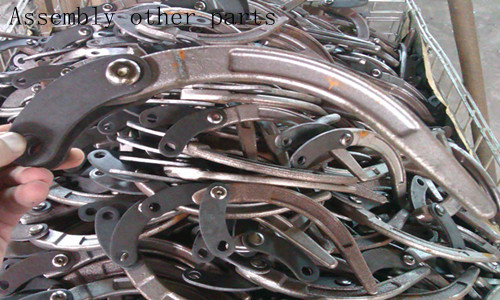
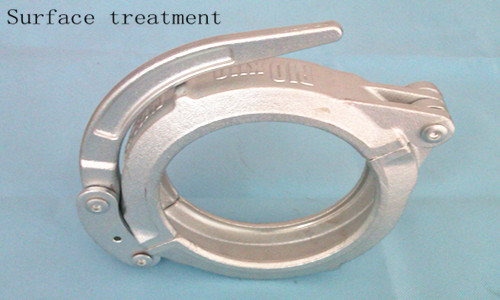
Concrete pump clamp Catalogue:
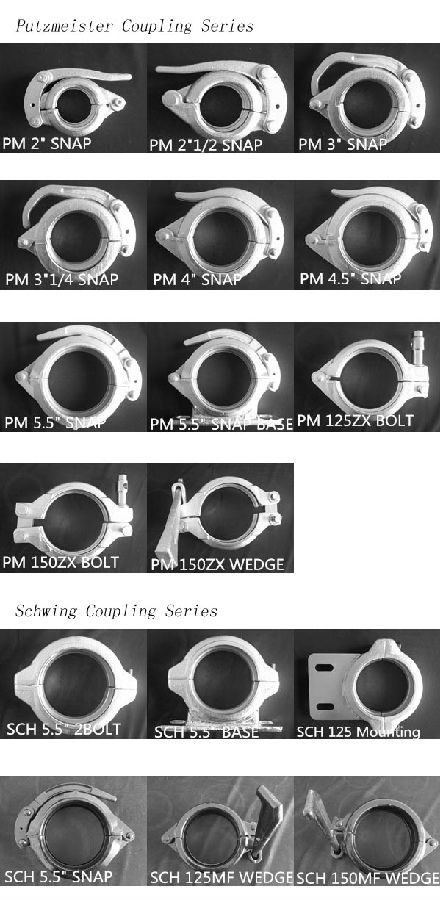
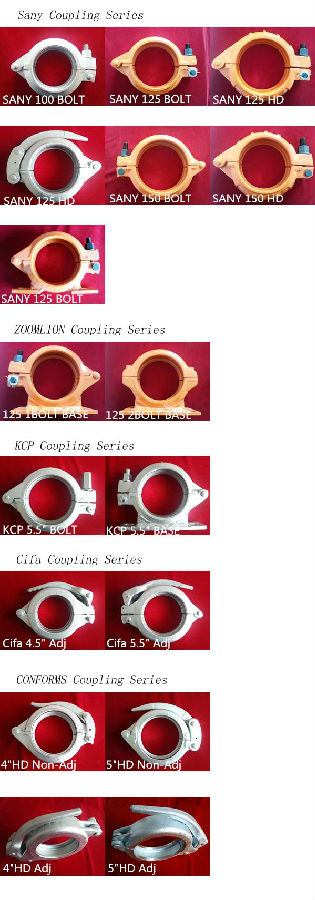
FAQ:
1.How do you regarding your product quality?
As our principle is more safety to save more. In China, there are lots of manufactures of this line, but we are the first one that use the forging technic in producing, firmly meet the PM standard.
2.Can I get some samples?
Of course you can. Small sample for free, but you pay the express. For some products are not small, like concrete pump pipe, it’s very difficult to deliver one pipe of 3000mm. If it’s possible, we’d like that you can come here to visit our factory. Welcome!
3. I want to make our logo on the products, is that ok?
Yes, it’s totally ok. OME is available from us.What you should do is send your logo, brand name, or picture to us. And let other things leave on us.
- Q: What are the signs of wear and tear in concrete pump spare parts?
- Some signs of wear and tear in concrete pump spare parts include cracks or fractures in the components, excessive vibration or noise during operation, decreased performance or efficiency, leaks or drips from seals or connectors, and visible corrosion or rust on metal parts. Additionally, worn-out or damaged rubber gaskets, seals, or O-rings can also indicate the need for replacement.
- Q: What are the potential risks of using non-standard or modified hydraulic components in concrete pump spare parts?
- Using non-standard or modified hydraulic components in concrete pump spare parts can pose several potential risks. Firstly, non-standard components may not have undergone the same rigorous testing and quality control as the original equipment manufacturer (OEM) parts. This means that their performance and durability may be compromised, leading to potential failures or malfunctions. Such failures can result in accidents, injuries, or damage to the equipment or surrounding structures. Secondly, using non-standard or modified components may void the warranty of the concrete pump and its spare parts. Manufacturers typically offer warranties to ensure the reliability and safety of their products. By using non-standard components, the warranty may become null and void, leaving the user responsible for any repairs or replacements needed due to issues arising from these non-standard parts. Another risk is the potential compatibility issues that may arise when using non-standard or modified components. Hydraulic systems rely on precise engineering and compatibility between various components to function optimally. Non-standard or modified parts may not fit properly or may have different specifications, leading to leaks, pressure imbalances, or reduced overall performance. Furthermore, the use of non-standard or modified components may also impact the overall efficiency and productivity of the concrete pump. OEM parts are designed to work seamlessly with the rest of the system, ensuring smooth operation and maximum output. By using non-standard parts, the performance of the pump may be compromised, resulting in increased downtime, decreased productivity, and higher maintenance costs. Lastly, the use of non-standard or modified components may also have legal and regulatory implications. In some jurisdictions, there may be regulations or standards in place that require the use of OEM or certified parts for certain equipment, including concrete pumps. Failure to comply with these regulations can result in fines, penalties, or legal liabilities in case of accidents or failures. In conclusion, the potential risks of using non-standard or modified hydraulic components in concrete pump spare parts include compromised performance and durability, warranty voidance, compatibility issues, reduced efficiency, and legal and regulatory implications. It is always advisable to use OEM or certified spare parts to ensure the safety, reliability, and optimal performance of the equipment.
- Q: How can a malfunctioning remote control affect the pumping operation?
- A malfunctioning remote control can significantly impact the pumping operation in various ways. Firstly, a remote control is used to operate the pump remotely, allowing operators to control the pump's speed, direction, and other important settings from a distance. If the remote control malfunctions, operators may lose the ability to control the pump effectively, leading to delays or inefficiencies in the pumping operation. Secondly, a malfunctioning remote control may result in inconsistent or erratic commands being sent to the pump. This can lead to unstable pump performance, potentially causing fluctuations in flow rates, pressure, or other critical parameters. Such inconsistencies can affect the overall efficiency and effectiveness of the pumping operation. Additionally, a malfunctioning remote control can pose safety risks. For instance, if the remote control fails to transmit accurate commands, it can potentially result in the pump operating at undesirable speeds or pressures, which may lead to equipment damage or accidents. Moreover, if operators are unable to control the pump remotely during emergencies or hazardous situations, it could hinder their ability to promptly respond and mitigate risks. Furthermore, a malfunctioning remote control may also impact the monitoring and control systems associated with the pumping operation. Remote controls are often integrated with centralized monitoring systems, allowing operators to collect real-time data and receive alerts or alarms. If the remote control fails, it may disrupt the flow of critical information, making it challenging for operators to monitor the pump's performance, identify potential issues, or make informed decisions. In conclusion, a malfunctioning remote control can have detrimental effects on the pumping operation by impeding the ability to control the pump remotely, causing erratic pump performance, posing safety risks, and hindering the monitoring and control systems. Therefore, it is crucial to regularly inspect and maintain remote controls to ensure their proper functionality and minimize any potential disruptions to the pumping operation.
- Q: How does a concrete pump piston work?
- A concrete pump piston works by using hydraulic pressure to push the concrete mixture from the hopper into the delivery pipeline. The piston moves back and forth inside a cylinder, creating suction on one side and pressure on the other. As the piston retracts, it creates a vacuum that draws the concrete mixture into the cylinder. On the forward stroke, the piston compresses the concrete, forcing it out through the discharge valve and into the delivery pipeline, allowing for efficient and continuous concrete pumping.
- Q: What is the purpose of a concrete pump wear plate?
- To safeguard the pumping system against the abrasive characteristics of concrete, a concrete pump wear plate is employed. In the course of transferring concrete from the mixer to the construction site, the wear plate acts as a shield, preventing direct contact between the pumping system and the abrasive concrete. Consequently, the detrimental effects caused by the constant flow of concrete are minimized. The wear plate is typically constructed from durable materials such as hardened steel or tungsten carbide, which possess resistance against the abrasive forces exerted by the concrete. By implementing a wear plate, the lifespan of the pumping system is significantly prolonged, thereby reducing the frequency of repairs and replacements. Ultimately, the objective of a concrete pump wear plate is to ensure the efficient and dependable operation of concrete pumps by safeguarding and preserving the integrity of the pumping system.
- Q: How can a malfunctioning control box affect the pump's operation?
- A malfunctioning control box can disrupt the pump's operation in several ways. It may fail to send accurate signals to the pump, leading to incorrect speed or pressure settings. This can result in inadequate water flow or excessive pressure, affecting the pump's efficiency and potentially causing damage. Moreover, a malfunctioning control box might also cause the pump to start or stop unexpectedly, leading to inconsistent operation and potential system failures.
- Q: What are the signs of a damaged concrete pump agitator motor?
- There are several signs that can indicate a damaged concrete pump agitator motor. 1. Unusual noises: If you hear excessive grinding, rattling, or squeaking noises coming from the agitator motor, it could be a sign of damage. These noises may indicate worn-out bearings or other internal components that need attention. 2. Inconsistent operation: A damaged agitator motor may result in irregular or inconsistent mixing of the concrete. If you notice that the concrete is not being mixed properly or if the agitation speed is inconsistent, it could be a sign that the motor is damaged. 3. Overheating: If the agitator motor becomes excessively hot during operation, it may indicate a problem. Overheating can be caused by various issues, such as a faulty motor or insufficient lubrication. In such cases, it is important to address the issue promptly to prevent further damage and potential breakdown. 4. Vibrations: Excessive vibrations during operation can be a sign of a damaged motor. Vibrations may occur due to imbalanced or misaligned components within the motor, which can result in reduced efficiency and increased wear and tear. 5. Electrical issues: If the motor is experiencing electrical problems, such as tripping circuit breakers or blowing fuses, it could indicate a damaged motor. Faulty wiring, short circuits, or damaged electrical components can lead to these issues and should be addressed by a professional. 6. Reduced performance: A damaged agitator motor may result in reduced performance or decreased efficiency. If you notice that the agitator is not working as effectively as it used to or if the concrete is not being mixed thoroughly, it could be a sign of motor damage. In any case, if you suspect that the concrete pump agitator motor is damaged, it is recommended to consult a professional technician or service provider familiar with concrete pump machinery. They can diagnose the issue accurately and provide appropriate solutions to repair or replace the damaged motor.
- Q: How often should concrete pump clamps be inspected and replaced?
- Concrete pump clamps should be inspected regularly, ideally before each use, to ensure they are in proper working condition. Depending on the frequency of usage and the operating conditions, replacement of clamps may be needed every few months or after a certain number of pumping hours. It is important to consult the manufacturer's guidelines and seek professional advice to determine the specific inspection and replacement schedule for concrete pump clamps.
- Q: Can I get spare parts for concrete pump boom arms and pipes?
- Yes, you can definitely get spare parts for concrete pump boom arms and pipes. There are various suppliers and manufacturers that specialize in providing spare parts for concrete pumps. These spare parts include boom arms, pipes, couplings, gaskets, seals, and other components that are necessary for the proper functioning of a concrete pump. You can search for these spare parts online, where you will find numerous websites and online stores that offer a wide range of options. It is important to ensure that you purchase spare parts from reputable suppliers to ensure their quality and compatibility with your specific concrete pump model. Additionally, there are also local dealers and distributors who stock spare parts for concrete pumps. You can inquire with them or visit their stores to find the required spare parts for your boom arms and pipes. Regular maintenance and replacement of worn-out or damaged parts is crucial for the efficient and safe operation of a concrete pump. By investing in high-quality spare parts, you can extend the lifespan of your equipment and ensure its optimal performance.
- Q: Can concrete pump spare parts be customized according to specific requirements?
- Concrete pump spare parts can indeed be customized to meet specific requirements. Numerous manufacturers offer customization options to cater to the unique needs and preferences of their customers. This enables the creation of spare parts that are specially designed to perfectly fit and function with a particular concrete pump model or brand. Customization can involve alterations in dimensions, materials, finishes, and other specifications to guarantee compatibility and enhance performance. Additionally, customization can also be implemented to satisfy specific environmental or project demands, such as corrosion resistance or tolerance for extreme temperatures. Overall, the capacity to personalize concrete pump spare parts provides flexibility and ensures the efficient and effective operation of the equipment in diverse construction projects.
Send your message to us
Concrete Pump Clamp DN80 3-1/4
- Loading Port:
- China main port
- Payment Terms:
- TT OR LC
- Min Order Qty:
- 20 PCS
- Supply Capability:
- 1000 PCS/month
OKorder Service Pledge
OKorder Financial Service
Similar products
Hot products
Hot Searches
Related keywords
